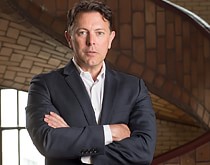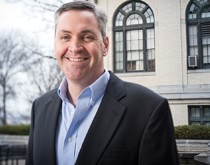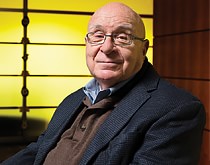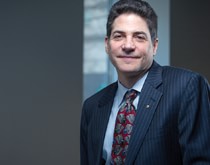Douglas Sicker was relaxing at home in Boulder, Colo., late on a summer evening. It had been a busy day, and he was happy to settle down to watch some HBO, ready for a few laughs. The computer science professor had led a meeting of network engineers earlier in the day, followed by drinks with the group. Afterwards, while the out-of-towners returned to their hotels, he headed home.
On his screen, a clean-cut British comedian sat smiling, hands clasped atop his desk, wearing a crisp blue shirt, burgundy tie, and sport coat. The segment began unassumingly but quickly gathered steam; a 13-minute hilarious and blistering rant, punctuated by photos, graphs, and laughter. On that first Sunday in June 2014, John Oliver, host of HBO’s “Last Week Tonight,” managed the impossible. He transformed a technical, eye-glazing debate into a pop-culture topic.
“Net neutrality,” Oliver began, “two words that promise … boredom,” he said while a stupefyingly monotonous CSPAN hearing played above his head. “The cable companies have figured out the great truth of America. If you want to do something evil, put it inside something boring.”
“Net neutrality essentially means that all data has to be treated equally,” Oliver went on, as the show played a news clip announcing that the Federal Communications Commission (FCC) was opening the door for a two-tiered system where giant internet service providers (ISPs), such as Comcast and Verizon, could charge to send content more quickly. It would allow “big companies to buy their way into the fast lane, leaving everyone else in the slow lane,” he asserted.
 As Oliver continued his witty entreaty for net neutrality, Sicker’s ears perked up. The FCC’s Chief Technology Officer in 2010-11, and previously senior advisor on the FCC’s 2010 National Broadband Plan, was more than mildly interested.
As Oliver continued his witty entreaty for net neutrality, Sicker’s ears perked up. The FCC’s Chief Technology Officer in 2010-11, and previously senior advisor on the FCC’s 2010 National Broadband Plan, was more than mildly interested.
Amid the one-liners, Oliver displayed a line graph of Netflix’s download speeds falling during a very public spat with Comcast, then pointed out the rapid improvement when terms were settled. “That has all the ingredients of a mob shakedown,” he declared.
Ranting on about the cozy relationship the cable industry enjoys with government, Oliver homed in on President Barack Obama’s appointment of FCC Chair Tom Wheeler. “The guy who used to run the cable industry’s lobbying arm is now running the agency tasked with its regulation. That’s the equivalent of needing a babysitter and hiring a dingo!” he exclaimed, below a photo of a wolf-like creature leering over a baby. He even pictured Comcast’s chief executive officer in a metal top hat and car—pointedly perched on a Monopoly game board.
The pinnacle of the bit came at the end. With ceremonial music rising in the background, Oliver stood and addressed the hordes of internet commenters, as the web address for the FCC site loomed large onscreen. “Good evening, monsters,” he exhorted, “we need you to get out there and … focus your indiscriminate rage in a useful direction. ... Turn on caps lock and fly my pretties. Fly! Fly!” he screamed, as the credits began to roll.
Sicker was just one of a million viewers tuned in that evening (YouTube views are now more than 9 million) as were many of Sicker’s colleagues from the telecom sector. “The next day, everyone was sharing links to that clip,” he recalls. “People could not stop talking about it.”
That same day, the FCC comment site shut down, evidently flooded. Comments eventually reached nearly 4 million. Those 13 minutes of razor-tongued entertainment had galvanized the public to a new issue that has, in reality, been under debate for more than a decade.
Lined up alongside Oliver in this polarized arena are the supporters of strong net neutrality regulation, including the ACLU, leading internet giants, and individuals like Tim Berners-Lee, creator of the web. They claim that equal treatment of all data is a core internet principle that protects freedom of speech, competition, and innovation. As one site warns, “AT&T or Comcast could block a service like Google Maps and charge for their own,” for example.
Across the ring stand the large ISPs—primarily Comcast, Verizon, AT&T, Time Warner, Cox, and Charter. The National Cable & Telecommunications Association (NCTA), the industry’s principal trade group, argues that harsh regulation would result in the opposite of its intended effect. They caution against “extremist voices,” declaring, “The internet works … because government has wisely chosen to let the web ... thrive without burdensome regulation and onerous red tape that can increase consumer bills, choke progress, and smother innovation.”
Then there are the rest of us—the myriad consumers and businesses, impacted as we pay our cable bills, watch our videos, sell our products, and much more: The aftermath of 2012’s Superstorm Sandy is one life-saving example:
 Wind and rain pummeled New Jersey in particular, causing widespread power outages. Before long—through Health Monitoring Systems (HMS), a small and growing company founded in 2006 by Kevin Hutchison (TPR’08)—local health officials were alerted to a surge in carbon monoxide poisonings turning up in area emergency rooms. In the aftermath of the chaos, officials spread the word about diesel-generator safety, educating residents with a public-awareness campaign.
Wind and rain pummeled New Jersey in particular, causing widespread power outages. Before long—through Health Monitoring Systems (HMS), a small and growing company founded in 2006 by Kevin Hutchison (TPR’08)—local health officials were alerted to a surge in carbon monoxide poisonings turning up in area emergency rooms. In the aftermath of the chaos, officials spread the word about diesel-generator safety, educating residents with a public-awareness campaign.
HMS was able to identify the poisonous surge because it collects anonymous hospital registration data in real time, analyzing the data to detect anything from infectious disease outbreaks like an Ohio flu spike to public policy impact, as when California Medicaid dropped dental benefits. HMS receives hundreds of thousands of messages a day over the internet from nearly 900 healthcare facilities. The company, its clients, and areas of public health, depend on quick, affordable, and reliable transmission. Needless to say, Hutchison has a vested interest in the topic of net neutrality.
“If we look down the road,” asks Hutchison, “could there be surcharges for quality data services or for data exchange between our 800 plus locations?”
“The point is,” he warns, “the ISPs can become very creative in their billing and/or quality of service. For small businesses that are internet reliant, they can basically block you out. Once they start to figure ways to charge for quality, I don’t see them stopping.”
Hutchison points out that the ability for an ISP to throttle (slow down), bottleneck, or compromise his data service in any way could spell real trouble for the young company, not to mention public education before and after the next superstorm.
When broadband was gaining traction back in 2000, the term net neutrality didn’t exist. By 2014, concern had skyrocketed. Why? What prompted Oliver’s tirade that summer evening?
The Rules. Broadband has been lightly regulated by the FCC for years, with the agency intervening primarily on a case-by-case basis. In 2010, however, amid legal wrangling and pressure for a more proactive approach, the commission drafted the Open Internet Rules “to preserve the free and open internet.” In basic terms, the rules were: transparency, no blocking, and no unreasonable discrimination. An ISP must openly ensure fair treatment for Amazon and HMS alike.
Sicker, now head of Carnegie Mellon’s Engineering and Public Policy (EPP) department and professor of computer science, had been the FCC’s Chief Technology Officer when those rules were written—and one of the lead authors. Sicker describes that period as an intense and “stressful” three months, including routine and lengthy weekend meetings. And against his opinion, “we did this in the dark,” he recalls. “Nobody was allowed to know we were writing [the rules] after talking about it for two years. I think that hurt long-term acceptance.”
In fact, with the ink barely dry, Verizon challenged the new order, filing suit in federal appeals court that the FCC didn’t have legal authority to regulate broadband. In January 2014, the court upheld the FCC’s ability to regulate broadband, but it struck down the “no blocking” and “no discriminating” sections.
This was because back in 2002, the FCC had chosen to classify ISPs as “information services” rather than as more heavily regulated telecommunications “common carriers” (under a provision of the Communications Act called Title II). Common carriers include railroads, airlines, and telephone services.
In response to the court ruling, the FCC proposed a new set of rules in the spirit of those just overturned, using the language “commercially reasonable” as a pricing standard. To net neutrality proponents, this was ominously vague—an invitation for ISPs to charge for those “fast lanes” that would leave little guys like HMS in the dust. That’s when Oliver rallied his minions to the cause.
Humor aside, Sicker notes that—as with many pressing policy issues—this one presents a more complicated, nuanced picture. He doesn’t even care for the phrase. “I dislike the term ‘net neutrality,’” he says. “I prefer ‘open internet.’ Net neutrality means that all data packets should be treated equally.” In other words, net neutrality, taken literally, implies Netflix data should be handled exactly like HMS’s.
However, in a sense, big content providers such as Netflix (which last fall Forbes magazine reported consumes about 35% of all North American broadband) have already created a web fast lane. By physically placing servers throughout the system and then storing copies of popular data closer to customers, the bits arrive faster. So, a Netflix customer in Manhattan watching “NCIS,” is likely doing so via a nearby server, not one in California.
“The fact is, networks already differentiate, in a number of ways, as part of their normal operation,” Sicker continues. “It’s not about differentiating. It’s about differentiating in a discriminatory and anti-competitive manner. If all data was treated equally, you wouldn’t be able to manage the networks.” Sicker also points to issues such as security management, where, by necessity, a network needs to drop malicious data to protect itself against attack.
Importantly, the internet is not just one network. It’s an interwoven system of multiple networks. Surprisingly, the many vital points of interconnection have been handled purely through private business deals—and largely unregulated. And over the years, the way data flows over this complex system has changed.
Early on, customers at the edges accessed their data through telephone lines (remember dial-up screeching and beeping?). Those local connections fed in and up through interconnected “backbone” companies. As broadband replaced dial-up, the largest service providers consolidated and built infrastructure, gaining market share.
 Those against stronger net neutrality rules point to the incredible growth and success of this complex system, warning that stringent regulation will backfire. Big companies might, for example, game the system. “People learn how to play the regulatory environment to get an edge,” notes David Farber, CMU professor emeritus, also a former FCC chief technologist, and regarded as one of the internet’s pioneering engineers for his contributions to programming languages and networking. If small innovators are forced into “fighting it out in front of the FCC with high-priced lawyers, they will lose,” he writes.
Those against stronger net neutrality rules point to the incredible growth and success of this complex system, warning that stringent regulation will backfire. Big companies might, for example, game the system. “People learn how to play the regulatory environment to get an edge,” notes David Farber, CMU professor emeritus, also a former FCC chief technologist, and regarded as one of the internet’s pioneering engineers for his contributions to programming languages and networking. If small innovators are forced into “fighting it out in front of the FCC with high-priced lawyers, they will lose,” he writes.
Regulation proponents point to historical abuses and the potential for more. In 2007, for example, Comcast, the nation’s largest cable TV operator and second largest ISP, blocked file sharing (often video) from customers using popular peer-to-peer networks. Critics believed Comcast was protecting its own on-demand video service. Defenders said it was protecting subscribers from bandwidth hogs.
Testimony in the case was streamed live. And, though John Oliver might find it boring, CMU EPP professor Jon Peha was intrigued. Comfortable in his living room in early 2008, he watched Comcast executives testify that their firm hadn’t engaged in blocking. What Peha heard made him so angry that he fired off an online comment to the FCC, stating that Comcast had made false statements. He went on, however, to urge a balanced FCC response.
A few days later, he received a surprising phone call. It was the FCC. Would he agree to testify on this issue? He did so—twice—and a few months later was asked to take on the position of chief technologist, which he held from 2008 to 2010. Prompted by the case, they began work in 2009 on open internet rules.
 Fundamentally, this is an issue over whether there should be gatekeepers to the internet,” explains Peha today. “With limited competition there’s potential danger that one or more of the ISPs will become a gatekeeper.”
Fundamentally, this is an issue over whether there should be gatekeepers to the internet,” explains Peha today. “With limited competition there’s potential danger that one or more of the ISPs will become a gatekeeper.”
“However,” he adds, “there’s also the risk that if the FCC goes too far, the agency itself could become a gatekeeper.” In other words, balance is key, or pick your poison.
In 2010, Sicker would also work on those same rules, and Verizon would quickly sue. And as the courts were striking the rules down in early 2014, another incident was playing out publicly, providing fodder for Oliver’s rant. It started when customers settled back to watch their favorite Netflix shows a few months before and instead got sputtering and buffering. Things improved, as Oliver so graphically noted, just as Netflix settled a dispute with Comcast that February.
So what was going on behind the scenes? It seems that the massive volume of Netflix data flowing through certain Comcast pipes was causing data rates to degrade, impacting reception. As a result, Comcast wanted compensation for the necessary infrastructure improvement. In public statements, Netflix cried foul. Reports later surfaced of a private monetary agreement between the two companies. Data rates improved, and a business model was turned on its head with the first two-party deal. Comcast was getting paid from not just the customer, but also the content provider.
The debate grew louder. Business deal or abuse of power? Should net neutrality pertain to just the “last mile” or to interconnection agreements as well?
Regulation advocates (including Netflix) point to the danger. If a Comcast can charge a Netflix, what’s to stop it from demanding payment from any content provider, from blocking someone who can’t pay? Could they drive a company like HMS out of business?
Regulation critics point to the deal’s logic. If Netflix clogs the pipes, they should pay to make them bigger. “Why should everyone subsidize fans of ‘House of Cards’?” asks the NCTA.
“There is nothing wrong with some companies or applications getting very good internet access,” insists Peha. “Problems occur if another user has no access to this very good service, or if ISPs tack on extra rents or favor affiliated services. Then who could get hurt? Anybody who has anything to do with the internet.”
“Fast lanes,” says Farber, “have existed for a long time, as in voice over IP.” [Skype is an example.] “The issue is, are they being used for anti-competitive situations?”
All of which leads to the million-dollar question—what to do? In November, the President, in an unusual move, urged the independent FCC toward “the strongest possible rules” and reclassification of ISPs as common carriers under Title II.
In late February, the commission did just that, reclassifying broadband as a telecommunications service subject to Title II regulations. Specifically, it agreed to rules banning paid priority service (the infamous fast lanes), blocking, and throttling, while forbearing (sidestepping) on the most restrictive provisions of Title II, meaning no rate regulation, tariffs, or last-mile unbundling. Comcast, for instance, would not be able to throttle peer-to-peer video sharing or unreasonably charge Netflix for its massive data stream.
Supporters were jubilant. “Internet freedom at last!” “A triumph for the American consumer,” and “Game-changing milestone,” were just some of the reactions by consumer groups, tech organizations, Democratic Congress members, and more.
Several experts, though, aren’t as ecstatic.
“There are a heck of a lot of problems with Title II classification,” Farber explains. “First, no amount of forbearance on the part of the current FCC will stop future commissions from creating mischief.” Like wading into rate regulation.
He cites other issues, like the increased likelihood of foreign and state telecommunications taxation on, for example, services like Skype, raising costs ”because it’s an ancient rule of the game. Companies don’t absorb things like that. They pass it on.” He points out that as an information service, the United States has successfully argued against the United Nations’ International Telecommunication Union asserting jurisdiction over the internet. He also expresses concern over declining investment in an uncertain regulatory environment.
In addition, the FCC, citing how 55% of internet traffic is currently carried over wireless networks, extended its regulatory reach for the first time to mobile broadband as well as interconnection.
“It’s a big mistake,” cautions Farber. “Everything’s different with wireless—different rules, different technologies. Wireless is still evolving.”
Hutchison points out an added wrinkle. “We all need to be aware that the ISPs are very sophisticated and have their strategies plotted out years in advance. We need to be very careful on how any new regulation affects future technologies. I can see the ISPs gladly accepting regulations that also apply to technologies like wireless and satellite because that would give them protection for their current space.”
Sicker worries that the FCC, while well-intentioned, needs to keep in mind “the potential for unintended technical and business implications.” Farber notes, “the FCC is lacking in deep technical understanding of what the networking does.”
Sicker favors a reactive, watch-and-see approach, believing the agency should be measured in its response, both literally and figuratively. It’s an area in which departments such as CMU’s EPP can make significant research contributions.
“I strongly believe that transparency and disclosure should remain a key part of the process going forward, principles I worked hard to include in the 2010 Order,” he says. “We also need better tools to measure performance across the internet to watch for potential problematic behavior by ISPs, application providers, and end users. Established rules can distort. The internet will continue to evolve, and you need to build policies that adapt.”
However one views the situation, it’s a pretty sure bet the new rules will continue to be challenged—in court, in Congress, or both.
“Odds are there will be lawsuits for years,” says Farber. “Everybody will get into the act.”
“It’s a long-term fight,” agrees Peha. “I’ve been in it since 1999 and don’t see it ending anytime soon.” j
Photo credit: Michael Confer Photography, Jon Boal Photography



